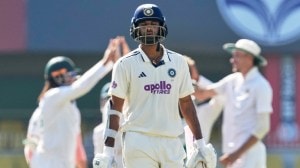A century for Mr Sarwan: The countdown begins
It could be just a question of keeping count. When Ramnaresh Sarwan comes to the crease at the fall of the first West Indian Test cricket, a...

It could be just a question of keeping count. When Ramnaresh Sarwan comes to the crease at the fall of the first West Indian Test cricket, a knowing buzz goes around the ground. This 21-year-old Guyanese batsman is going to stabilise the innings, he is going to chip in with a confident, classy 50. And then duly return to the pavilion.
His record says it all. In 22 matches, Sarwan has scored 13 half-centuries at an impressive average of 39.31. Though no hundreds so far. In the series just concluded too Sarwan was part of the backbone of the West Indian revival, along with Guyana teammates Carl Hooper and Shivnarine Chanderpaul. Five Tests, four fifties, 45.28 average.
It’s a measure of the wonderful things expected from Sarwan that this phenomenal early career record fades away amidst speculation about that elusive century. It’s getting to him too.
“As much as I’m saying it’s not bothering me, it’s at the back of my mind now,” he says. “That three-figure mark is playing on my mind.”
“For the past couple of months I have been very consistent. I’ve scored a lot of 50s — 60s, 70s and 80s. I’m pleased with the way I am batting, it’s just unfortunate that I’m not carrying on to get a big score,” he said.
Why? “Maybe one of the reasons is a lack of concentration. Shot selection as well. It’s something I would have to work on to be able to get it right.” And then he reveals the trouble with keeping count: “When I start my innings I would be thinking, you’re batting from one to 10, you’re trying to build an innings, play straight in the V. But from the time I get to 50, I would start thinking about a 100 instead of the small goals I had set for myself — one to 10, 10 to 20.
“I need to pay more attention: from 50 to 60, 70, etc. I think that’s where I lose it.”
Sarwan, often compared to the legendary Rohan Kanhai, burst on the scene in 1996, when at 15 he became the youngest ever first-class player in the West Indies.
The promise of rare potential was kept when he thrilled observers with his orthodox technique and wristy shots, making 84 on debut against Pakistan at the Kensington Oval in Bridgetown, to date his favourite ground. As too when he attempts his two favourite shots: the cover drive (deemed cricket’s grandest stroke) and the square cut.
Comparisons with Kanhai are accepted as a huge honour, he notes, but he clarifies that his idol is Hooper. “I’ve been looking at Carl since I was a kid,” says Sarwan. “Actually he was the first person who told me I would be playing Test cricket for the West Indies. He’s always advising me. He knows how to motivate me.”
But Hooper’s hitting the last, glorious stretch in a long, enigmatic career. “Yes,” agrees Sarwan sadly, catching the drift right away, zipping ahead to that lonely day when Hooper’s presence will be a warm memory. “I keep thinking about that day when he will retire,” he murmurs.
This, however, is the Caribbean, and cricket is a thing of joy. Sarwan points out that’s the key to success. “You have to enjoy your cricket. Once you can enjoy it, you’ll be able to perform. Even if you’re in a pressure situation, you have to relax, have fun.
“I’m not saying you should lose your focus. You shouldn’t be too tense.” How? “There’s always music around the ground. Whenever there’s a break between overs, you try to get into the rhythm of the song that’s playing. That itself is relaxing.”
Away matches, with their more sterile atmosphere, thus require a little adjustment. “I’ll listen to music on my discman before we go to the ground,” says the Guyanese number three bat. “Sometimes I start singing but not all the time. Especially when I reach a tough situation I start singing in between overs, or in between balls, very quietly in my mind. It helps to relax me.” What music? “Soul, R&B and a little bit of Indian, though I don’t know the meaning of the Indian lyrics but it’s the rhythm.”
That Indian heritage is still a bit of a mystery. Born in Essiquibo island and schooled in Georgetown, where at the tender age of 11 he was told he had it in him to become a great cricketer, his Indian origins manifests itself in little ways. In his Hindu beliefs.
In questions to his parents about exactly how many generations ago his ancestors arrived here (“I knew I would be asked about this”). In a passion for Hindi films, understood with subtitles and savoured with a touching openness (“Yeah, I cried while watching Dilwale Dulhaniya Le Jayenge“).
And in gracious empathy for the visitors: “It’s different playing against India. I’m feeling a bit for them because I know it was important for them to win an away series. But I would have to look at our team as well. Because we have been losing, I’m happy we won against India because they are a pretty strong team.”
In a kaleidoscope of identities: “When I’m home in Guyana I’m referred to as an Indian. If I’m in England as a Guyanese. In the Caribbean I’m West Indian.” For now, it’s back to negotiating the future in little capsules. “I’ve set myself a lot of small goals,” Sarwan explains.
“Three years from now I want to see if I can get into the top 10 in the world. As time goes by I would have to readjust my goals, but I would keep as small and achievable as possible.”
That quantum approach to cricket sure seems to be clicking.



- 01
- 02
- 03
- 04
- 05




























